Abstract
Based on the observed membrane structures of substance P, physalaemin, and eledoisin, preferred conformations, orientations and accumulations of 13 mammalian neurokinins and non-mammalian tachykinins were estimated and compared with pharmacologic and selective binding data taken from the literature. Principal site affinities and relative affinities supported the view that neurokinins bind to three principal mammalian sites: the NK-1 (preferring substance P), the NK-2 (preferring neurokinin A), and the NK-3 site (preferring neurokinin B). Strong hydrophobic membrane interaction of the C-terminal message segment as a perpendicularly oriented alpha-helical domain correlated with NK-1 selection. Electrostatic accumulation of the peptide at the anionic fixed charge layer of the membrane without hydrophobic interaction through a helix correlated with NK-2 preference. Electrostatic repulsion by the anionic fixed charge layer correlated with NK-3 selection. Thus, neurokinin receptor selection is guided by the same principles as opioid receptor selection. Membrane catalysis of specific agonist--receptor interactions may prove to be a quite general phenomenon, and the membrane structure of a peptide more important for its structure--activity relationship than its crystal structure or its mixture of conformers in solution or in vacuo.
Full text
PDF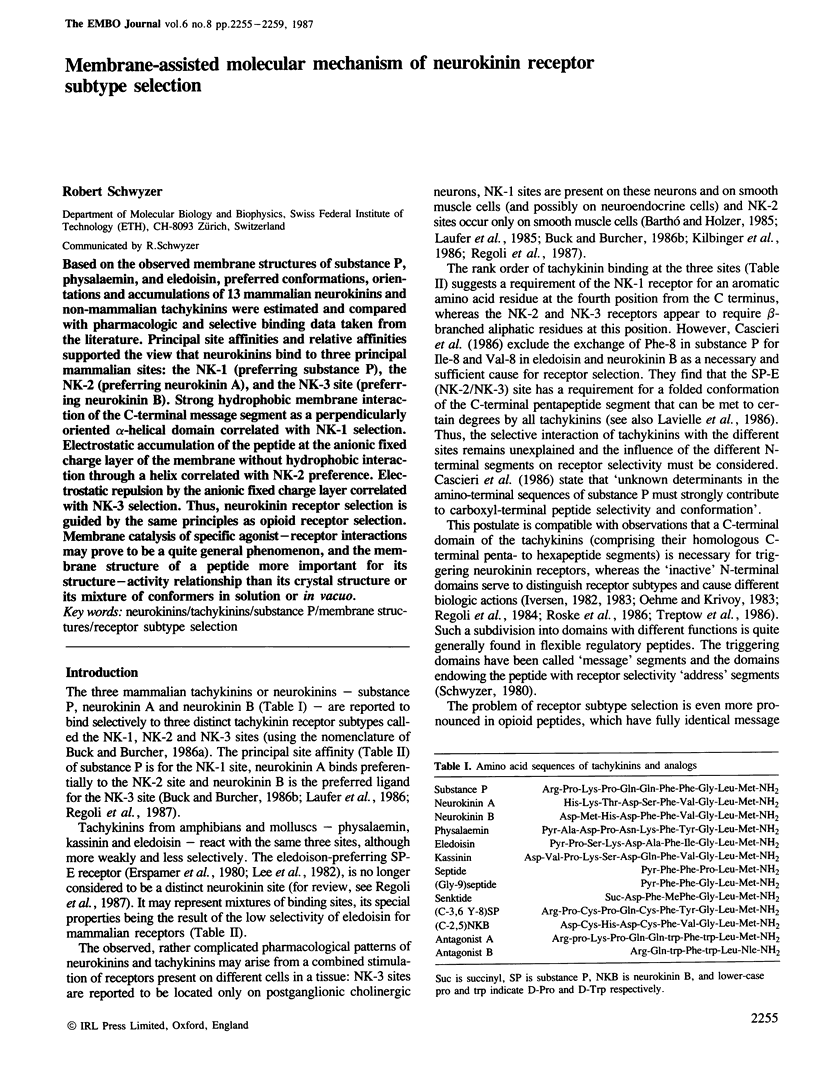
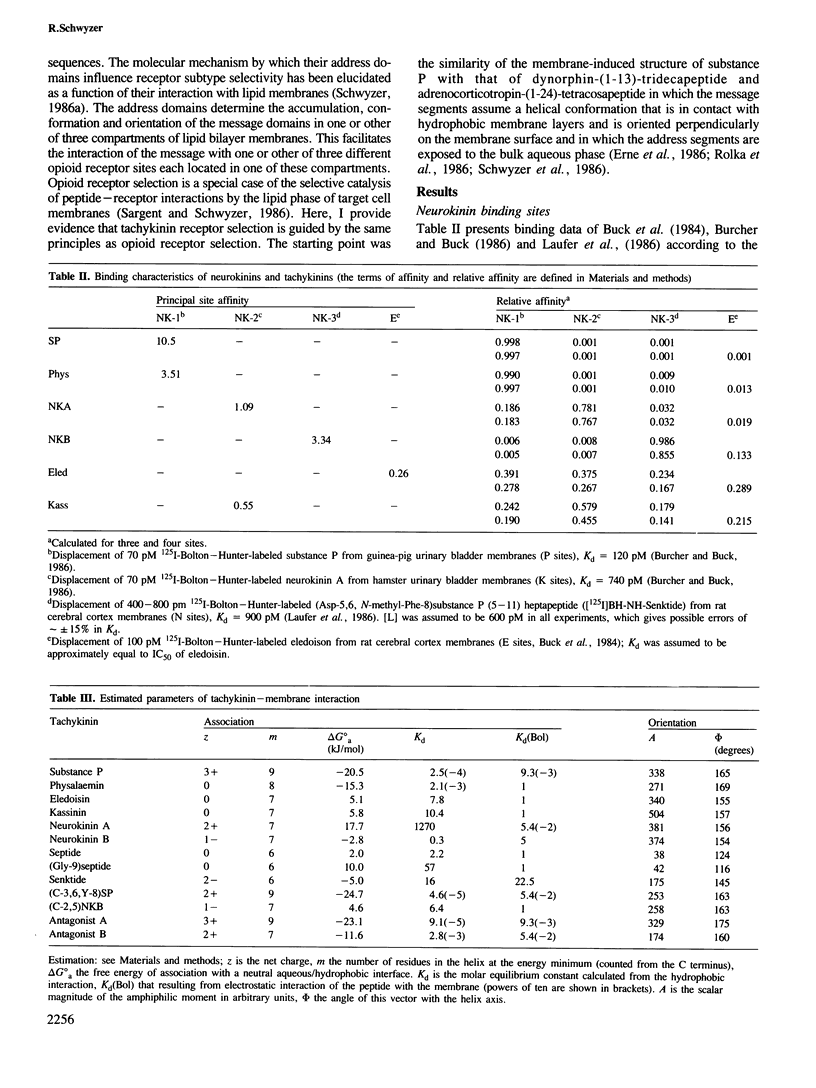
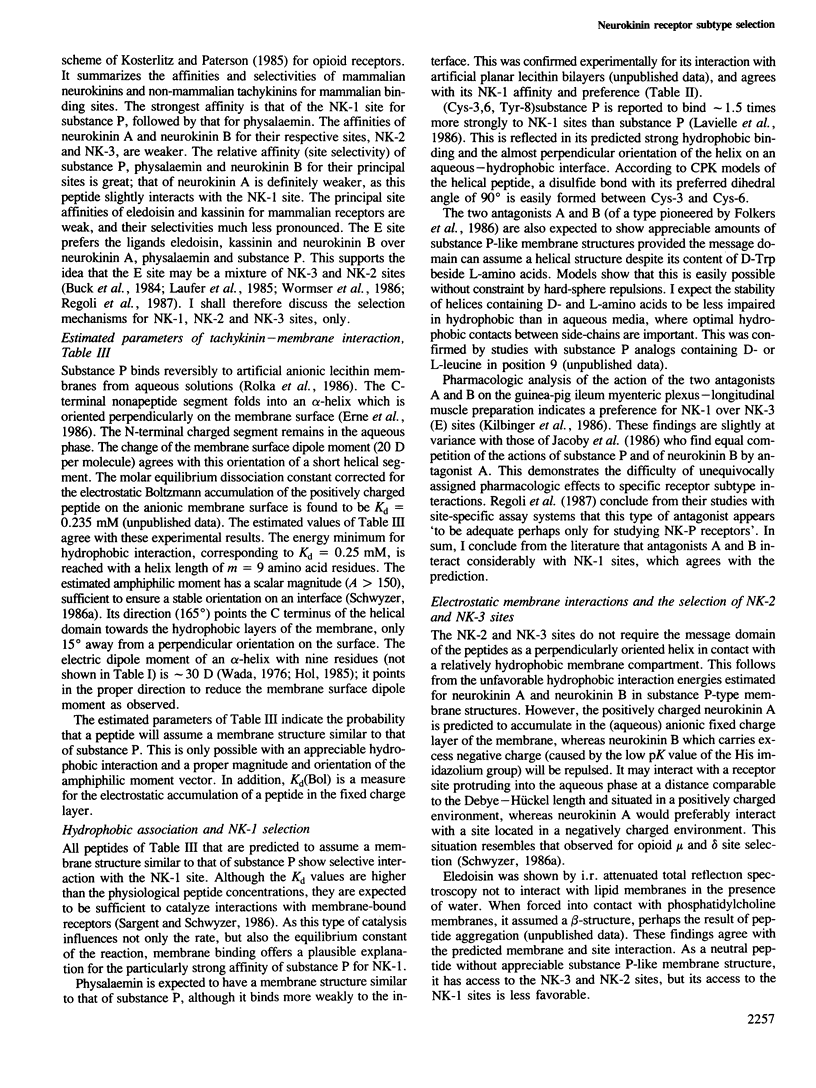
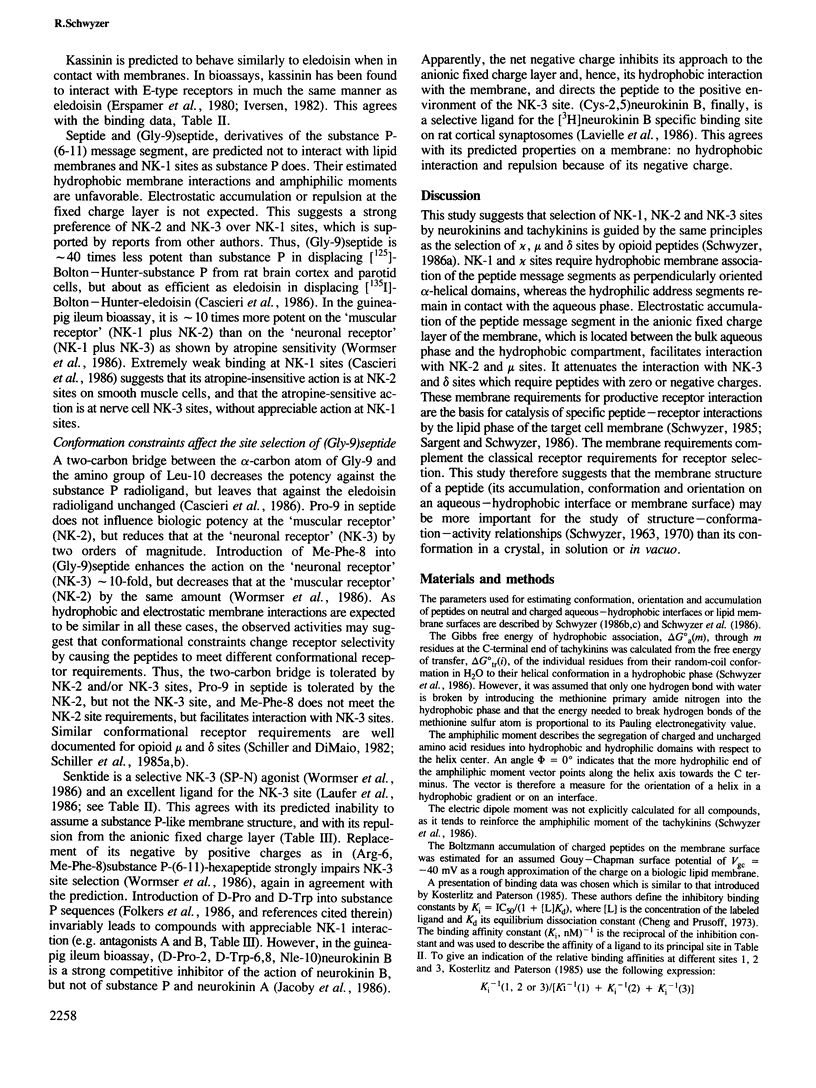
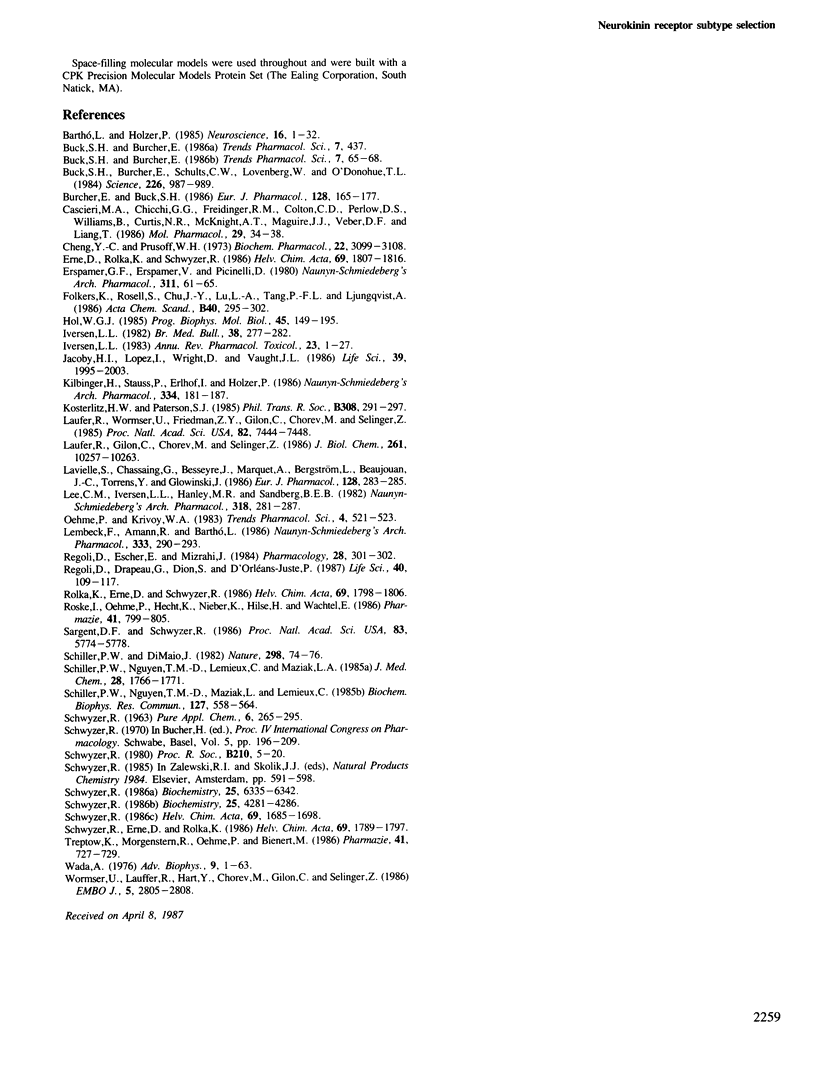
Selected References
These references are in PubMed. This may not be the complete list of references from this article.
- Barthó L., Holzer P. Search for a physiological role of substance P in gastrointestinal motility. Neuroscience. 1985 Sep;16(1):1–32. doi: 10.1016/0306-4522(85)90043-0. [DOI] [PubMed] [Google Scholar]
- Buck S. H., Burcher E., Shults C. W., Lovenberg W., O'Donohue T. L. Novel pharmacology of substance K-binding sites: a third type of tachykinin receptor. Science. 1984 Nov 23;226(4677):987–989. doi: 10.1126/science.6095447. [DOI] [PubMed] [Google Scholar]
- Burcher E., Buck S. H. Multiple tachykinin binding sites in hamster, rat and guinea-pig urinary bladder. Eur J Pharmacol. 1986 Sep 9;128(3):165–177. doi: 10.1016/0014-2999(86)90763-6. [DOI] [PubMed] [Google Scholar]
- Cascieri M. A., Chicchi G. G., Freidinger R. M., Colton C. D., Perlow D. S., Williams B., Curtis N. R., McKnight A. T., Maguire J. J., Veber D. F. Conformationally constrained tachykinin analogs which are selective ligands for the eledoisin binding site. Mol Pharmacol. 1986 Jan;29(1):34–38. [PubMed] [Google Scholar]
- Cheng Y., Prusoff W. H. Relationship between the inhibition constant (K1) and the concentration of inhibitor which causes 50 per cent inhibition (I50) of an enzymatic reaction. Biochem Pharmacol. 1973 Dec 1;22(23):3099–3108. doi: 10.1016/0006-2952(73)90196-2. [DOI] [PubMed] [Google Scholar]
- Erspamer G. F., Erspamer V., Piccinelli D. Parallel bioassay of physalaemin and kassinin, a tachykinin dodecapeptide from the skin of the African frog Kassina senegalensis. Naunyn Schmiedebergs Arch Pharmacol. 1980 Feb;311(1):61–65. doi: 10.1007/BF00500303. [DOI] [PubMed] [Google Scholar]
- Folkers K., Rosell S., Chu J. Y., Lu L. A., Tang P. F., Ljungqvist A. Design and synthesis of antagonists of substance P. Acta Chem Scand B. 1986 Apr;40(4):295–302. doi: 10.3891/acta.chem.scand.40b-0295. [DOI] [PubMed] [Google Scholar]
- Hol W. G. The role of the alpha-helix dipole in protein function and structure. Prog Biophys Mol Biol. 1985;45(3):149–195. doi: 10.1016/0079-6107(85)90001-x. [DOI] [PubMed] [Google Scholar]
- Iversen L. L. Nonopioid neuropeptides in mammalian CNS. Annu Rev Pharmacol Toxicol. 1983;23:1–27. doi: 10.1146/annurev.pa.23.040183.000245. [DOI] [PubMed] [Google Scholar]
- Iversen L. L. Substance P. Br Med Bull. 1982 Sep;38(3):277–282. doi: 10.1093/oxfordjournals.bmb.a071773. [DOI] [PubMed] [Google Scholar]
- Jacoby H. I., Lopez I., Wright D., Vaught J. L. Differentiation of multiple neurokinin receptors in the guinea pig ileum. Life Sci. 1986 Nov 24;39(21):1995–2003. doi: 10.1016/0024-3205(86)90323-1. [DOI] [PubMed] [Google Scholar]
- Kilbinger H., Stauss P., Erlhof I., Holzer P. Antagonist discrimination between subtypes of tachykinin receptors in the guinea-pig ileum. Naunyn Schmiedebergs Arch Pharmacol. 1986 Oct;334(2):181–187. doi: 10.1007/BF00505819. [DOI] [PubMed] [Google Scholar]
- Kosterlitz H. W., Paterson S. J. Types of opioid receptors: relation to antinociception. Philos Trans R Soc Lond B Biol Sci. 1985 Feb 19;308(1136):291–297. doi: 10.1098/rstb.1985.0029. [DOI] [PubMed] [Google Scholar]
- Laufer R., Gilon C., Chorev M., Selinger Z. Characterization of a neurokinin B receptor site in rat brain using a highly selective radioligand. J Biol Chem. 1986 Aug 5;261(22):10257–10263. [PubMed] [Google Scholar]
- Laufer R., Wormser U., Friedman Z. Y., Gilon C., Chorev M., Selinger Z. Neurokinin B is a preferred agonist for a neuronal substance P receptor and its action is antagonized by enkephalin. Proc Natl Acad Sci U S A. 1985 Nov;82(21):7444–7448. doi: 10.1073/pnas.82.21.7444. [DOI] [PMC free article] [PubMed] [Google Scholar]
- Lavielle S., Chassaing G., Besseyre J., Marquet A., Bergström L., Beaujouan J. C., Torrens Y., Glowinski J. A cyclic analogue selective for the NKB specific binding site on rat brain synaptosomes. Eur J Pharmacol. 1986 Sep 9;128(3):283–285. doi: 10.1016/0014-2999(86)90779-x. [DOI] [PubMed] [Google Scholar]
- Lee C. M., Iversen L. L., Hanley M. R., Sandberg B. E. The possible existence of multiple receptors for substance P. Naunyn Schmiedebergs Arch Pharmacol. 1982 Mar;318(4):281–287. doi: 10.1007/BF00501166. [DOI] [PubMed] [Google Scholar]
- Lembeck F., Amann R., Barthó L. Studies on effects of the substance P analogues [D-Pro2, D-Trp7,9]-substance P and [D-Arg1, D-Trp7,9, L-Leu11]-substance P not related to their antagonist action. Naunyn Schmiedebergs Arch Pharmacol. 1986 Jul;333(3):290–293. doi: 10.1007/BF00512943. [DOI] [PubMed] [Google Scholar]
- Regoli D., Drapeau G., Dion S., D'Orléans-Juste P. Pharmacological receptors for substance P and neurokinins. Life Sci. 1987 Jan 12;40(2):109–117. doi: 10.1016/0024-3205(87)90349-3. [DOI] [PubMed] [Google Scholar]
- Regoli D., Escher E., Mizrahi J. Substance P--structure-activity studies and the development of antagonists. Pharmacology. 1984;28(6):301–320. doi: 10.1159/000137979. [DOI] [PubMed] [Google Scholar]
- Roske I., Oehme P., Hecht K., Nieber K., Hilse H., Wachtel E. Zur Bedeutung des N-Terminus des Substanz P-Moleküls für die Wirkung auf stressbedingte Verhaltens- und Blutdruckstörungen. Pharmazie. 1986 Nov;41(11):799–805. [PubMed] [Google Scholar]
- Sargent D. F., Schwyzer R. Membrane lipid phase as catalyst for peptide-receptor interactions. Proc Natl Acad Sci U S A. 1986 Aug;83(16):5774–5778. doi: 10.1073/pnas.83.16.5774. [DOI] [PMC free article] [PubMed] [Google Scholar]
- Schiller P. W., DiMaio J. Opiate receptor subclasses differ in their conformational requirements. Nature. 1982 May 6;297(5861):74–76. doi: 10.1038/297074a0. [DOI] [PubMed] [Google Scholar]
- Schiller P. W., Nguyen T. M., Lemieux C., Maziak L. A. Synthesis and activity profiles of novel cyclic opioid peptide monomers and dimers. J Med Chem. 1985 Dec;28(12):1766–1771. doi: 10.1021/jm00150a005. [DOI] [PubMed] [Google Scholar]
- Schiller P. W., Nguyen T. M., Maziak L., Lemieux C. A novel cyclic opioid peptide analog showing high preference for mu-receptors. Biochem Biophys Res Commun. 1985 Mar 15;127(2):558–564. doi: 10.1016/s0006-291x(85)80196-0. [DOI] [PubMed] [Google Scholar]
- Schwyzer R. Estimated conformation, orientation, and accumulation of dynorphin A-(1-13)-tridecapeptide on the surface of neutral lipid membranes. Biochemistry. 1986 Jul 29;25(15):4281–4286. doi: 10.1021/bi00363a016. [DOI] [PubMed] [Google Scholar]
- Schwyzer R. Molecular mechanism of opioid receptor selection. Biochemistry. 1986 Oct 7;25(20):6335–6342. doi: 10.1021/bi00368a075. [DOI] [PubMed] [Google Scholar]
- Schwyzer R. Structure and function in neuropeptides. Proc R Soc Lond B Biol Sci. 1980 Oct 29;210(1178):5–20. doi: 10.1098/rspb.1980.0115. [DOI] [PubMed] [Google Scholar]
- Treptow K., Morgenstern R., Oehme P., Bienert M. The essential sequence of substance P for locomotion. Pharmazie. 1986 Oct;41(10):727–729. [PubMed] [Google Scholar]
- Wada A. The alpha-helix as an electric macro-dipole. Adv Biophys. 1976:1–63. [PubMed] [Google Scholar]
- Wormser U., Laufer R., Hart Y., Chorev M., Gilon C., Selinger Z. Highly selective agonists for substance P receptor subtypes. EMBO J. 1986 Nov;5(11):2805–2808. doi: 10.1002/j.1460-2075.1986.tb04571.x. [DOI] [PMC free article] [PubMed] [Google Scholar]


